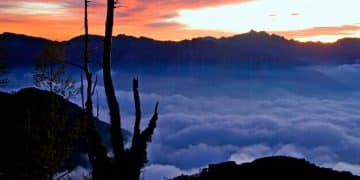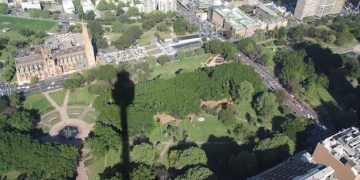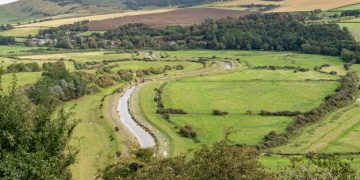Rainbow Mountain Day Trip from Cusco: A US Adventurer’s Guide
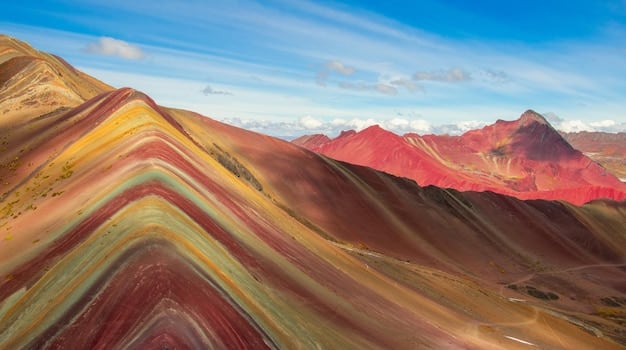
Embark on an unforgettable day trip from Cusco to Rainbow Mountain, Peru, a high-altitude adventure showcasing stunning geological formations and breathtaking Andean landscapes, perfect for US adventurers seeking unique travel experiences.
Dreaming of an adventure that combines breathtaking landscapes with a touch of cultural immersion? A day trip from Cusco to Rainbow Mountain offers just that, promising an unforgettable experience for US adventurers eager to explore the wonders of Peru.
Rainbow Mountain: A Must-See for US Travelers in Peru
Rainbow Mountain, locally known as Vinicunca, has quickly become one of Peru’s most popular tourist destinations. Its vibrant colors and stunning Andean scenery draw adventurers from around the globe, including many from the US. A day trip from Cusco is the most common way to experience this natural wonder.
What Makes Rainbow Mountain So Special?
The unique coloration of Rainbow Mountain is due to the mineral deposits in the soil. Over millions of years, various minerals have layered on top of each other, creating the distinct stripes we see today. Combined with the high-altitude setting, this creates a truly breathtaking vista.
Practical Considerations for US Travelers
Before embarking on your Rainbow Mountain adventure, it’s important to consider the altitude. The mountain sits at over 16,000 feet (4,900 meters), so acclimatization is essential. US travelers should spend a few days in Cusco to adjust to the altitude before attempting the hike. Additionally, packing appropriately for the weather is crucial, as conditions can change rapidly.
- Altitude Sickness: Spend at least 2-3 days in Cusco prior to the trek.
- Weather: Pack layers, including warm clothing, rain gear, and sunscreen.
- Physical Fitness: Be prepared for a challenging hike at high altitude.
In summary, Rainbow Mountain offers US travelers a unique and awe-inspiring experience. By understanding the factors that make it special and preparing accordingly, you can ensure a safe and enjoyable adventure through the Peruvian Andes.
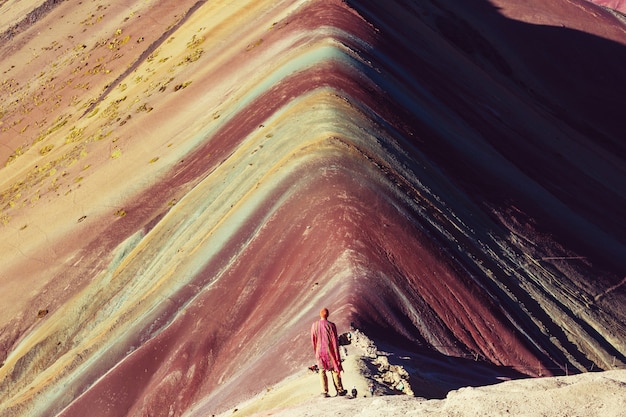
Planning Your Day Trip from Cusco
Planning a day trip from Cusco to Rainbow Mountain requires careful consideration. Several tour operators offer organized excursions, which often include transportation, meals, and a guide. Alternatively, independent travelers can arrange their own transportation and hire a local guide at the trailhead.
Choosing a Tour Operator
When selecting a tour operator, consider the inclusions and the group size. Smaller group tours can offer a more personalized experience, while larger groups may be more budget-friendly. Read reviews and compare prices to find the best option for your needs.
Independent Travel Options
For those who prefer independent travel, it’s possible to arrange transportation through a taxi or private driver. However, keep in mind that the road to Rainbow Mountain can be challenging, and hiring a local guide is highly recommended. A guide can provide valuable insights into the local culture and ensure your safety on the trail.
What to Expect on the Day Trip
The day trip typically starts early in the morning, with a pick-up from your hotel in Cusco. The drive to the trailhead takes around 3-4 hours, followed by a 2-3 hour hike to the summit. Be prepared for a long day, and pace yourself during the hike to avoid altitude sickness.
- Early Start: Expect a 3:00-4:00 AM pick-up.
- Long Drive: The journey to the trailhead is lengthy but scenic.
- Challenging Hike: The altitude makes the hike demanding, even for experienced hikers.
In conclusion, careful planning is essential for a successful day trip from Cusco to Rainbow Mountain. Whether you choose a tour operator or opt for independent travel, understanding the logistics and challenges involved will help you make the most of this incredible adventure.
Packing Essentials for Rainbow Mountain
Packing appropriately is crucial for a comfortable and safe day trip to Rainbow Mountain. The weather at high altitude can be unpredictable, and the hike can be physically demanding. Bringing the right gear will help you cope with the elements and ensure an enjoyable experience.
Clothing
Layers are key when it comes to clothing. Start with a base layer of moisture-wicking material, followed by a fleece or sweater for warmth. A waterproof and windproof jacket is essential for protection against the elements. Also, bring comfortable hiking pants and sturdy hiking boots.
Gear and Accessories
In addition to clothing, consider bringing the following gear and accessories: a hat and gloves to protect against the cold, sunscreen and sunglasses to shield against the sun, a water bottle to stay hydrated, and a backpack to carry your essentials. Trekking poles can also be helpful for stability on the trail.
Personal Items
Don’t forget to pack any personal items you may need, such as medication, snacks, and a camera to capture the stunning scenery. A small first-aid kit is also a good idea, in case of minor injuries. Cash is useful for purchasing souvenirs or snacks from local vendors.
- Layers: Dress in layers to adapt to changing weather conditions.
- Protection: Protect yourself from the sun, wind, and cold.
- Essentials: Carry water, snacks, and any necessary medication.
In summary, packing wisely is essential for a comfortable and safe day trip to Rainbow Mountain. By bringing the right clothing, gear, and personal items, you’ll be well-prepared to tackle the challenges of the altitude and enjoy the stunning landscapes.
Acclimatization and Altitude Sickness
Acclimatization is a critical factor for a safe and enjoyable trip to Rainbow Mountain. The mountain’s high altitude can cause altitude sickness, which can range from mild to severe. Understanding how to acclimatize and recognizing the symptoms of altitude sickness is essential for US travelers.
Understanding Altitude Sickness
Altitude sickness, also known as acute mountain sickness (AMS), occurs when your body has difficulty adjusting to the lower oxygen levels at high altitude. Symptoms can include headache, nausea, fatigue, dizziness, and shortness of breath. In severe cases, it can lead to life-threatening conditions such as pulmonary edema (fluid in the lungs) or cerebral edema (fluid in the brain).
Acclimatization Strategies
The best way to prevent altitude sickness is to acclimatize gradually. Spend at least 2-3 days in Cusco before attempting the Rainbow Mountain hike, allowing your body to adjust to the altitude. Avoid strenuous activity during your first few days, and drink plenty of water. Consider taking altitude sickness medication, such as acetazolamide (Diamox), as prescribed by your doctor.
Recognizing and Treating Altitude Sickness
If you experience symptoms of altitude sickness, stop ascending and rest. Drink plenty of water and avoid alcohol and caffeine. Mild symptoms can often be treated with over-the-counter pain relievers and anti-nausea medication. If symptoms worsen, descend to a lower altitude immediately and seek medical attention.
Acclimatization is key to a safe trip to Rainbow Mountain. Listen to your body, take it slow, and don’t hesitate to seek medical advice if needed.
The Cultural Experience Around Rainbow Mountain
A trip to Rainbow Mountain is not only about the stunning landscapes, but also about the cultural experience. The trek takes you through rural Andean communities, where you can interact with local people and learn about their way of life. This cultural immersion adds a unique dimension to the adventure.
Interacting with Local Communities
As you hike towards Rainbow Mountain, you’ll pass through small villages and encounter local people. Take the opportunity to greet them, learn a few basic Quechua phrases, and ask questions about their culture and traditions. Remember to be respectful and mindful of their customs.
Supporting Local Economies
By purchasing souvenirs or snacks from local vendors, you can directly support the local economy. Bargain respectfully, and be mindful of the prices they are asking. Your purchases can help improve their livelihoods and contribute to the sustainability of the community.
Respecting Local Customs
When visiting Rainbow Mountain and the surrounding communities, it’s important to respect local customs and traditions. Dress modestly, avoid taking photos without permission, and be mindful of noise levels. Remember that you are a guest in their community, and your behavior can have an impact on their lives.
- Greeting Locals: Learn a few basic Quechua phrases to greet the local people.
- Supporting Economy: Purchase souvenirs and snacks from local vendors to support the economy.
- Being Respectful: Respect their traditions by dressing modestly and asking for permission before taking photos.
In conclusion, the cultural experience around Rainbow Mountain is an integral part of the adventure. By interacting with local communities, supporting their economies, and respecting their customs, you can enrich your trip and contribute to the well-being of the people who call this region home.
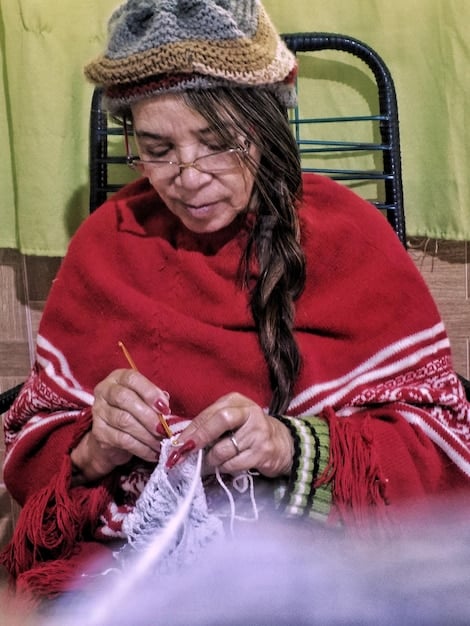
Capturing the Perfect Rainbow Mountain Photo
Rainbow Mountain is a photographer’s dream, offering endless opportunities to capture stunning images. However, getting the perfect shot requires some planning and patience. Consider the lighting, composition, and weather conditions to create memorable photographs.
Lighting
The best time to photograph Rainbow Mountain is during the early morning or late afternoon, when the light is soft and warm. Avoid shooting during midday, when the light is harsh and can wash out the colors. Cloudy days can also be challenging, as the colors may appear dull.
Composition
Experiment with different compositions to find the most visually appealing shot. Consider using the rule of thirds, leading lines, and foreground elements to add depth and interest to your images. Include people in your photos to show the scale of the landscape and add a sense of adventure.
Weather Conditions
Weather conditions can change rapidly at Rainbow Mountain. Be prepared for rain, wind, and fog, which can affect the visibility and colors. If the weather is unfavorable, wait for a break in the clouds or try a different angle. Sometimes, the most dramatic photos are taken during challenging weather conditions.
- Golden Hours: Capture the best light during early morning or late afternoon.
- Compositional Elements: Use the rule of thirds, leading lines, and foreground elements.
- Weather Preparation: Be ready to photograph in various weather conditions, from sunshine to fog.
In summary, capturing the perfect Rainbow Mountain photo requires planning, patience, and a bit of luck. By considering the lighting, composition, and weather conditions, you can create images that truly capture the beauty and majesty of this incredible landscape.
Alternative Treks and Activities Near Rainbow Mountain
While Rainbow Mountain is the main attraction in the area, there are several alternative treks and activities that US adventurers might find appealing. Exploring these options can enhance your experience and provide a deeper understanding of the region’s natural and cultural heritage.
Palccoyo Rainbow Mountain
If you’re looking for a less crowded alternative to Vinicunca (the traditional Rainbow Mountain), consider visiting Palccoyo. This area features not just one, but three rainbow mountains, along with stunning views of the surrounding valleys. The hike is also shorter and less strenuous than the Vinicunca trek, making it a great option for those who prefer a more relaxed adventure.
Red Valley (Valle Rojo)
Adjacent to Rainbow Mountain is the Red Valley, a landscape characterized by its striking red soil. This area offers unique photo opportunities and a different perspective on the Andean geology. You can often combine a visit to Rainbow Mountain with a hike through the Red Valley.
Ausangate Trek
For experienced hikers seeking a multi-day adventure, the Ausangate Trek is an excellent choice. This challenging trek circles the towering Ausangate Mountain, the highest peak in the Cusco region, and takes you through remote Andean landscapes, past glaciers, hot springs, and traditional villages. The Ausangate Trek usually takes 4-6 days to complete.
Exploring these alternatives can provide a richer and more diverse experience in the Rainbow Mountain region. Whether you prefer a less crowded hike, a unique landscape, or a challenging multi-day trek, there’s something for every US adventurer to discover.
| Key Point | Brief Description |
|---|---|
| ⛰️ Altitude Acclimatization | Spend 2-3 days in Cusco before trekking to avoid altitude sickness. |
| 🎒 Packing Essentials | Layers, hiking boots, sunscreen, water, and snacks are crucial for the trek. |
| 📸 Photography Tips | Best light is in the early morning or late afternoon for vibrant colors. |
| 🤝 Cultural Respect | Engage respectfully with locals, support their economy, and honor their customs. |
Frequently Asked Questions
▼
The hike is considered moderately challenging due to the high altitude. It takes around 2-3 hours to reach the summit, and acclimatization is essential.
▼
The dry season, from May to September, offers the best weather conditions for hiking. However, it’s also the busiest time of year, so expect larger crowds.
▼
Yes, you can visit Rainbow Mountain independently by arranging your own transportation and hiring a local guide at the trailhead. However, a tour can simplify the logistics and provide valuable insights.
▼
If you experience symptoms of altitude sickness, stop ascending and rest. Drink plenty of water, avoid alcohol and caffeine, and consider descending to a lower altitude if symptoms worsen.
▼
Basic facilities, such as restrooms and small shops selling snacks and souvenirs, are available at the trailhead. However, it’s advisable to bring your own water and snacks.
Conclusion
A day trip from Cusco to Rainbow Mountain is an unforgettable adventure for US travelers seeking a unique and awe-inspiring experience. From the vibrant landscapes to the cultural immersion, this trek offers a perfect blend of natural beauty and cultural enrichment.

